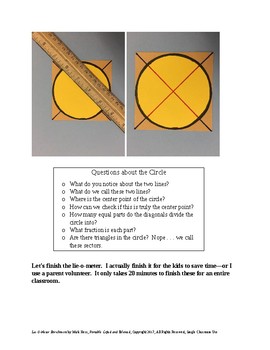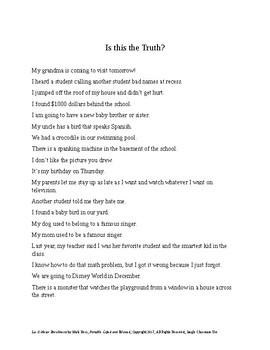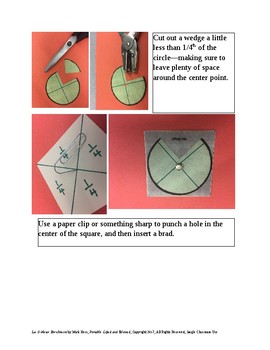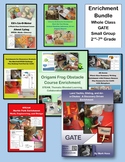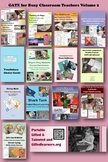The Lie-O-Meter - A WHOLE CLASS ENRICHMENT ABOUT LYING +Literacy, STEM, Math
Portable Gifted and Talented
3.1k Followers
Grade Levels
1st - 4th, Homeschool
Subjects
Resource Type
Standards
CCSS2.G.A.3
CCSS3.G.A.2
CCSSRL.2.3
CCSSRL.2.6
CCSSRL.2.7
Formats Included
- Word Document File
Pages
21 pages
Portable Gifted and Talented
3.1k Followers
Also included in
- You're ready for a fantastic year with 225 pages and 8 enrichment lessons at 50% off the individual prices! Grades 2-6.SEE THE INDIVIDUAL PREVIEWSENRICHMENT FOR THE WHOLE CLASS OR GATE PULL-OUTSGet kids excited about literacy with the Bookmarks Primary Sources lesson.The origami frog obstacle coursPrice $19.99Original Price $30.43Save $10.44
- Volume 1 is hugely popular and contains comment after comment from teachers about engaging, time-saving lessons. Here is volume 2 . . . just as good (actually, probably better in many ways--shhh!)50% off individual purchases with this collection! Hours and hours and hours! Ready to go today!One ofPrice $34.99Original Price $57.40Save $22.41
Description
Having trouble with lying in the classroom or on the playground?
Social-emotional lessons, inferences, theme, characterization, STEM, fractions and geometry … all here!
Try this engaging social-emotional whole-class enrichment lesson. It’s not just about lying. The lessons are filled with standards including math and literature standards for 2nd and 3rd grades as well as a little STEM construction project.
All you will need to get started is this lesson are common school materials and the picture book, Eli’s Lie-O-Meter by Sandra Leving.
This school year we’re working on filling up the portable with whole-class enrichment lessons. These lessons are designed to be used by a gifted resource teacher in a “push-in” model or for classroom teachers who want to reach all levels of ability in an engaging way.
Each lesson opens with a whole class lesson in which students respond naturally within their ability.
Further enrichment opportunities are differentiated for higher abilities and/or for students who have a passion for the topic. This lesson includes an extension for highly creative or gifted learners.
Taught in Sessions:
Critical Thinking Questions about the Story
Identification of the Story’s Theme
Building the Lie-O-Meter in a mini STEM Project including Geometery Applications
Using the Lie-O-Meter to Detect Truth and Lies
Using the Lie-O-Meter for Challenging Applications with Fractions
Creative Extension Activity
Our discussion about lying was absolutely one of the best discussions I’ve had with a group of kids. We ended up talking about so much more than lies.
We talked about
• Kindness
• Friendship
• Fairness
• Consequences of our Actions
• Why people believe lies.
• Whether there are really monsters.
• Evidence
• Whether more than one opinion can be right.
• Why people lie.
• Why people are sometimes mean.
• How lies can hurt others.
• How it feels to be lied to.
…and much more.
Time: About 2-3 hours – easily broken into sessions. 1 hour creative or gifted extension.
Level: Best for 2nd and 3rd Grades
Materials: Common school materials and the book, Eli’s Lie-O-Meter.
Social-emotional lessons, inferences, theme, characterization, STEM, fractions and geometry … all here!
Try this engaging social-emotional whole-class enrichment lesson. It’s not just about lying. The lessons are filled with standards including math and literature standards for 2nd and 3rd grades as well as a little STEM construction project.
All you will need to get started is this lesson are common school materials and the picture book, Eli’s Lie-O-Meter by Sandra Leving.
This school year we’re working on filling up the portable with whole-class enrichment lessons. These lessons are designed to be used by a gifted resource teacher in a “push-in” model or for classroom teachers who want to reach all levels of ability in an engaging way.
Each lesson opens with a whole class lesson in which students respond naturally within their ability.
Further enrichment opportunities are differentiated for higher abilities and/or for students who have a passion for the topic. This lesson includes an extension for highly creative or gifted learners.
Taught in Sessions:
Critical Thinking Questions about the Story
Identification of the Story’s Theme
Building the Lie-O-Meter in a mini STEM Project including Geometery Applications
Using the Lie-O-Meter to Detect Truth and Lies
Using the Lie-O-Meter for Challenging Applications with Fractions
Creative Extension Activity
Our discussion about lying was absolutely one of the best discussions I’ve had with a group of kids. We ended up talking about so much more than lies.
We talked about
• Kindness
• Friendship
• Fairness
• Consequences of our Actions
• Why people believe lies.
• Whether there are really monsters.
• Evidence
• Whether more than one opinion can be right.
• Why people lie.
• Why people are sometimes mean.
• How lies can hurt others.
• How it feels to be lied to.
…and much more.
Time: About 2-3 hours – easily broken into sessions. 1 hour creative or gifted extension.
Level: Best for 2nd and 3rd Grades
Materials: Common school materials and the book, Eli’s Lie-O-Meter.
Total Pages
21 pages
Answer Key
Included
Teaching Duration
Other
Report this resource to TPT
Reported resources will be reviewed by our team. Report this resource to let us know if this resource violates TPT’s content guidelines.
Standards
to see state-specific standards (only available in the US).
CCSS2.G.A.3
Partition circles and rectangles into two, three, or four equal shares, describe the shares using the words halves, thirds, half of, a third of, etc., and describe the whole as two halves, three thirds, four fourths. Recognize that equal shares of identical wholes need not have the same shape.
CCSS3.G.A.2
Partition shapes into parts with equal areas. Express the area of each part as a unit fraction of the whole. For example, partition a shape into 4 parts with equal area, and describe the area of each part as 1/4 of the area of the shape.
CCSSRL.2.3
Describe how characters in a story respond to major events and challenges.
CCSSRL.2.6
Acknowledge differences in the points of view of characters, including by speaking in a different voice for each character when reading dialogue aloud.
CCSSRL.2.7
Use information gained from the illustrations and words in a print or digital text to demonstrate understanding of its characters, setting, or plot.


